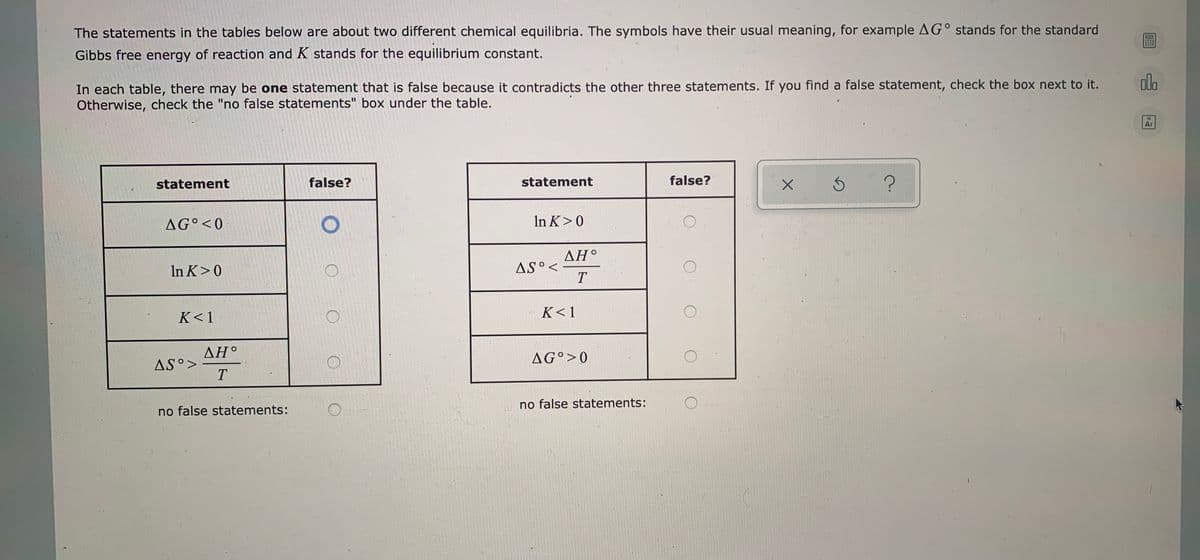The statements in the tables below are about two different chemical equilibria. The symbols have their usual meaning, for example AG° stands for the standard Gibbs free energy of reaction and K stands for the equilibrium constant. In each table, there may be one statement that is false because it contradicts the other three statements. If you find a false statement, check the box next to it. Otherwise, check the "no false statements" box under the table. statement false? statement false? AG°<0 In K>0 AH° In K>0 AS°< T K<1 K<1 AH° AG°>0 AS°> T no false statements: no false statements:
The statements in the tables below are about two different chemical equilibria. The symbols have their usual meaning, for example AG° stands for the standard Gibbs free energy of reaction and K stands for the equilibrium constant. In each table, there may be one statement that is false because it contradicts the other three statements. If you find a false statement, check the box next to it. Otherwise, check the "no false statements" box under the table. statement false? statement false? AG°<0 In K>0 AH° In K>0 AS°< T K<1 K<1 AH° AG°>0 AS°> T no false statements: no false statements:
Chemistry by OpenStax (2015-05-04)
1st Edition
ISBN:9781938168390
Author:Klaus Theopold, Richard H Langley, Paul Flowers, William R. Robinson, Mark Blaser
Publisher:Klaus Theopold, Richard H Langley, Paul Flowers, William R. Robinson, Mark Blaser
Chapter16: Thermodynamics
Section: Chapter Questions
Problem 48E: At mom temperature, the equilibrium constant (Kw) for the self-ionization of water is 1.001014....
Related questions
Question

Transcribed Image Text:The statements in the tables below are about two different chemical equilibria. The symbols have their usual meaning, for example AG° stands for the standard
Gibbs free energy of reaction and K stands for the equilibrium constant.
dlo
In each table, there may be one statement that is false because it contradicts the other three statements. If you find a false statement, check the box next to it.
Otherwise, check the "no false statements" box under the table.
18
Ar
statement
false?
statement
false?
AG°<0
In K>0
AH°
In K>0
AS°<
T
K<1
K<1
ΔΗ.
AG°>0
AS°>
T
no false statements:
no false statements:
Expert Solution
This question has been solved!
Explore an expertly crafted, step-by-step solution for a thorough understanding of key concepts.
This is a popular solution!
Trending now
This is a popular solution!
Step by step
Solved in 5 steps with 6 images

Knowledge Booster
Learn more about
Need a deep-dive on the concept behind this application? Look no further. Learn more about this topic, chemistry and related others by exploring similar questions and additional content below.Recommended textbooks for you

Chemistry by OpenStax (2015-05-04)
Chemistry
ISBN:
9781938168390
Author:
Klaus Theopold, Richard H Langley, Paul Flowers, William R. Robinson, Mark Blaser
Publisher:
OpenStax

Chemistry: The Molecular Science
Chemistry
ISBN:
9781285199047
Author:
John W. Moore, Conrad L. Stanitski
Publisher:
Cengage Learning

Introductory Chemistry: A Foundation
Chemistry
ISBN:
9781337399425
Author:
Steven S. Zumdahl, Donald J. DeCoste
Publisher:
Cengage Learning

Chemistry by OpenStax (2015-05-04)
Chemistry
ISBN:
9781938168390
Author:
Klaus Theopold, Richard H Langley, Paul Flowers, William R. Robinson, Mark Blaser
Publisher:
OpenStax

Chemistry: The Molecular Science
Chemistry
ISBN:
9781285199047
Author:
John W. Moore, Conrad L. Stanitski
Publisher:
Cengage Learning

Introductory Chemistry: A Foundation
Chemistry
ISBN:
9781337399425
Author:
Steven S. Zumdahl, Donald J. DeCoste
Publisher:
Cengage Learning

General Chemistry - Standalone book (MindTap Cour…
Chemistry
ISBN:
9781305580343
Author:
Steven D. Gammon, Ebbing, Darrell Ebbing, Steven D., Darrell; Gammon, Darrell Ebbing; Steven D. Gammon, Darrell D.; Gammon, Ebbing; Steven D. Gammon; Darrell
Publisher:
Cengage Learning

Chemistry & Chemical Reactivity
Chemistry
ISBN:
9781133949640
Author:
John C. Kotz, Paul M. Treichel, John Townsend, David Treichel
Publisher:
Cengage Learning

Chemistry & Chemical Reactivity
Chemistry
ISBN:
9781337399074
Author:
John C. Kotz, Paul M. Treichel, John Townsend, David Treichel
Publisher:
Cengage Learning